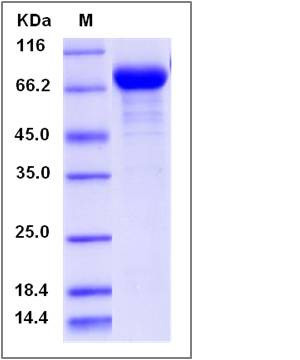Human ENPP5 Protein (His Tag)
NPP-5
- 100ug (NPP3825) Please inquiry
| Catalog Number | P11519-H08H |
|---|---|
| Organism Species | Human |
| Host | Human Cells |
| Synonyms | NPP-5 |
| Molecular Weight | The recombinant human ENPP5 is a disulfide-linked homodimer. The reduced monomer comprises 416 amino acids and has a predicted molecular mass of 48.1 kDa. The apparent molecular mass of the protein is approximately 81 kDa in SDS-PAGE under reducing conditions. |
| predicted N | Pro 25 |
| SDS-PAGE |  |
| Purity | > 96 % as determined by SDS-PAGE |
| Protein Construction | A DNA sequence encoding the human ENPP5 (Q9UJA9) (Met1-Gly429) with a C-terminal polyhistidine tag was expressed. |
| Bio-activity | |
| Research Area | |
| Formulation | Lyophilized from sterile PBS, pH 7.4 1. Normally 5 % - 8 % trehalose, mannitol and 0.01% Tween80 are added as protectants before lyophilization. Specific concentrations are included in the hardcopy of COA. |
| Background | ENPP5 is a member of the nucleotide pyrophosphatase/phosphodiesterase family(NPP). It is a family comprised by dimeric enzymes that catalyze the hydrolysis of phosphate diester bonds. There are seven isoforms in NPP family, some of which prefer nucleotide substrates, some of which prefer phospholipid substrates, and others of which prefer substrates that have not yet been determined. NPP also belongs to the alkaline phosphatase (AP) superfamily of enzymes and they are located in the cell membrane and hydrolyze extracellular phosphate diesters to affect a wide variety of biological processes. ENPP5 belongs to a group of nucleotidemetabolizing ectoenzymes, which regulate the availability of extracellular nucleotides. ENPP5 may play a role in neuronal cell communication. Hhowever, it lacks nucleotide pyrophosphatase and lysopholipase D activity. It may also be involved in neuronal cell communication. The amino acid sequence of human ENPP5 is 100%, 88%, and 82% identical to that of chimpanzee, dog and mouse/rat. ENPP5 functions in phospholipid metabolism. |
| Reference |
